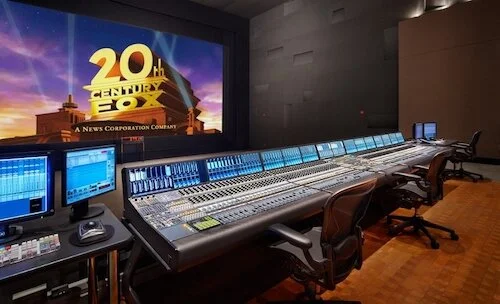Sound Lesson: The Difference Between Sound Editing and Sound Mixing
Whenever Oscar season came around, one question I would be asked year after year would be this: “what’s the difference between sound editing and sound mixing?”. Now, that likely won’t happen again if the Academy’s wishes to combine both categories into one gets fulfilled (I personally think this is foolish, and I hope this lesson proves my reasons why). Of course, I will most certainly not be the first person to ever cover this topic, but, seeing as I discuss it often during awards season and aim to have every film related lesson featured on this site, I’m going to quickly cover it today anyway.
In short, the difference is easy. Sound editing is the creation and/or accumulation of sounds. Sound mixing is the piecing-together of sounds to blend every noise together.
We could finish the article right there and then, but let’s go deeper into both fields so you really get a sense of what each field specializes in specifically.
Sound Editing
Again, sound editing is the creation and recording of sounds to be used in a film. It can be confusing, because editing in film is the piecing together (and removal) of scenes and shots. You may think that sound editing is similar, just with sounds. That’s not the case. Sound editing refers to the actual sounds themselves, not how they are mixed together (hence the “mix” in sound mixing). In film, you have three primary types of sound: character dialogue, music, and various effects. An editor will take recorded dialogue and refine it, perhaps rounding out a word that gets cut off a little too early during the splicing of shots. Enhancements can also be provided here, including vocal deepening, reverb, or whatever is necessary. However, the true extent of sound editing comes from the effects that are created.
So, how are these sounds created?
•Field Recording
For environment sounds — say, nature noises by a lake, or the engines of cars during rush hour — field recording can be used. It’s also important for room tone to be recorded and used in a film, especially in more quiet scenes, so the final mix isn’t just a series of static dialogue, music, and sound waves. Room tone isn’t field recording, but it fulfils the same goal of filling up a scene’s palette. Additionally, specific noises can also be picked up through field recording, although it isn’t ideal. For intentioned sounds, you will likely refer to Foley artists. Say a plane is flying overhead in an airport. You can’t control how obstructive an on-set plane will be, whereas including a created artificial plane sound (or one from a sound library) will be easier to control.
•Foley Artists
Named after innovator Jack Foley, a Foley artist is someone who creates the sounds necessary in a private studio setting. Even some of the most basic noises, including footsteps in snow, can be recreated or made from scratch by Foley artists. Although not every film follows this, a number of motion pictures are made with only the dialogue of characters being picked up on set, so their words aren’t clouded by external noises; this is the reason for a boom mic and anything similar, which rests above the focal points’ heads. Of course, sounds are needed to fill up the scene, so a Foley artist will use creative measures to depict what is happening on screen.
Here is revered Foley artist Mark Costanzo with examples of how these sounds are made.
•Additional Dialogue Read
Additional Dialogue Reading — or ADR, as it is commonly referred to — is the practice of having performers record, well, additional dialogue. Say a scene in a rough cut of a film doesn’t quite make sense. If there’s an opportune moment, a performer can read a line in a studio that can be added into the scene. Here’s an example of the necessity and the opportune moment:
1) Max says to Sally: “I think we need to talk.”
2) Sally says to Max: “I know. I was aware of your feelings this whole time. Goodbye, Max.”
3) Sally gets up, and Max turns his head to Sally in amazement.
4) Scene cuts to Sally and Max in court.
It’s a bit confusing, right? So, what could happen is the actress for Sally could be brought back in to record a line. What can be done to make this process easier, is to have a subtitle at the bottom of the scene in question, stating what should be said to clean up this wonky transition. Maybe cut 3 could have a subtitle saying “(ADR) Sally: I’ve already contacted my lawyer. You’ll have divorce papers in the mail shortly.” This works, because Sally can be off screen at this moment, and you can’t see her face. The illusion is kept.
Now, this is how the scene reads:
1) Max says to Sally: “I think we need to talk.”
2) Sally says to Max: “I know. I was aware of your feelings this whole time. Goodbye, Max.”
3) Sally gets up, and Max turns his head to Sally in amazement. Sally says: “I’ve already contacted my lawyer. You’ll have divorce papers in the mail shortly.”
4) Scene cuts to Sally and Max in court.
A sound editor can also try and clean up the vocal recordings if they are clearly not from the same session. Even the tiniest differences in tone, quality, and nature can shatter the illusion and sound like a line being tossed in. I’ll give you an ear-opening example.
Naturally, as this is a Gordon Ramsay clip, there will be coarse language. Reader discretion is advised.
Gordon Ramsay is notorious for the over-production of his American shows, and the inclusion of lines after the matter is part of that case that can be made. If you fast forward to two minutes in (while Ramsay is in the middle of berating a restaurant owner in this Kitchen Nightmares clip), he will go on about the lies of the owner cleaning. Right afterwards, Ramsay says the line “Telling me the food is great, and people love it”, before he continues. That very line is almost certainly recorded in post by Ramsay, seeing as it’s a point he forgot to make during this confrontation. If you listen really closely, that line does not sound anything like the ones before and after it (which both sound like they came from the same recording themselves). Better sound editing would have created a better illusion that’s seamless. Also notice how the line is said when the camera is facing away from Ramsay. You can also blame this on mixing, but to me this is mainly an editing problem.
Of course, sound editors can also choose to work with sound libraries (of which there are many) instead of working with Foley artists if they’re not absolutely needed (for a television production, a lower budgeted film, and similar money-saving circumstances). Proper sound editing (to clean up or slightly change the sound) and mixing (to help it blend in better) will hide stock sounds that may be overused. Otherwise, these sounds become painfully obvious every single time you hear them, and compilations like this can exist.
Sound Mixing
Sound mixing is the blending of all of these sounds together. Think of music production. Has a high hat ever been a little too loud in the mix, making your favourite song now sound uncomfortable with that constant sound going off? Has a beat been slightly off, ruining the flow of the rhythm? Sound mixing in film works the same way. It’s about balancing the levels of all of the sounds, and making sure they hit their marks at the right times. This is much easier said than done. Having so many sounds and songs going off at once — especially in action sequences or other noisy environments — can have too much going on and cause the levels of the scene to go “in the red” (or begin to distort with the levels clashing at such a high volume or amount of noises). No one wants to hear an ear-shattering, distorted film. A mixer has to make sure this doesn’t happen either.
Here’s a brief look at working with different mixes for different purposes, by Buck Moore on his channel Bacontrees.
The main goal is to make every sound audible and distinctive from everything else, and yet you aren’t overly bombarded. However, there are creative means for sound mixing. Here’s a traditionally well mixed scene in Roma.
Here’s a high-volume action sequence from Mad Max: Fury Road to test the limits of sound mixing in a scene.
Now, for a creative example, here’s this clip from 50/50, where a character zones out after hearing his test results from a doctor. The sound begins to fuzz, and a sharp tinnitus-like ringing begins to overtake the scene, fully realizing the disconnection the character has with his surroundings for that short amount of time. Whatever the doctor says is nothing more than murky echoes of inaudible speech.
To wrap up this lesson, here is an incredibly useful guide to sound mixing for beginning independent filmmakers by The Film Look. Notice how the video discusses Foley sounds, ambience, and library stock noises, but none of them are made in the video. Instead, they are mixed into the film.
Maybe you can see why I get defensive when sound gets blended into one generic category. Even just labeling fields as “sound editing” and “sound mixing” is a bit presumptuous, given the amount of work and people needed for each field, and the expertise of everyone involved. I hope you have a clearer distinction of both fields now, either way.
Andreas Babiolakis has a Masters degree in Film and Photography Preservation and Collections Management from Ryerson University, as well as a Bachelors degree in Cinema Studies from York University. His favourite times of year are the Criterion Collection flash sales and the annual Toronto International Film Festival.





